Adventure
-Paul
McDougall
Leopard (Panthera pardus)

The Leopard is one of the most widely distributed cats in Africa, but also one of the hardest
to see due to its choice of dense habitat and the fact that it is generally nocturnal. The male Leopard is larger than the female but otherwise both sexes are very similar. The Leopard is a typical cat. Adults only associate long enough to mate and the young
become independent as sub-adults around 22 months. Female territories tend to overlap and they are very tolerant of their female offspring often sharing kills. Leopards are thought to copulate as many times as Lions, they can breed at 2 years and give birth
to 1-3 cubs. Leopards spend the day and part of the night inactive, draped over a tree limb or perhaps lying in a dense thicket. They move around at intervals throughout the night and for a couple of hours after dawn. Leopards although not as vocal as lions
have a very distinct call usually heard in the early evening or at dawn it is a sound very similar to someone sawing wood. A Leopard is the perfect ambush and stalking predator, it seeks to pounce before its prey can react. Leopards can consume antelopes
up to twice its weight although medium sized antelopes like Impala, Reedbuck and Thompson Gazelle form the majority of its diet. After killing its prey the Leopard usually drags it up a tree and caches it there where it returns to feed for several days. A
Leopard kill in a tree is often the closest that many safari goers will get to see this elusive cat. Despite predictions of extermination, it turns out that Leopards are far commoner than conservationists had first thought. The Leopard is successful wherever
the habitat provides reasonable cover and a variety of medium sized antelope for prey. Leopards can be seen in all of the main parks and reserves in Kenya. They are usually seen on a 3 day+ safari to Masai Mara especially around migration time. Lake Nakuru
is also very good for Leopard and has the highest density of Leopards in any Kenyan National Park or Reserve. Saiwa swamp is infamous for its black leopards although these are rarely seen.
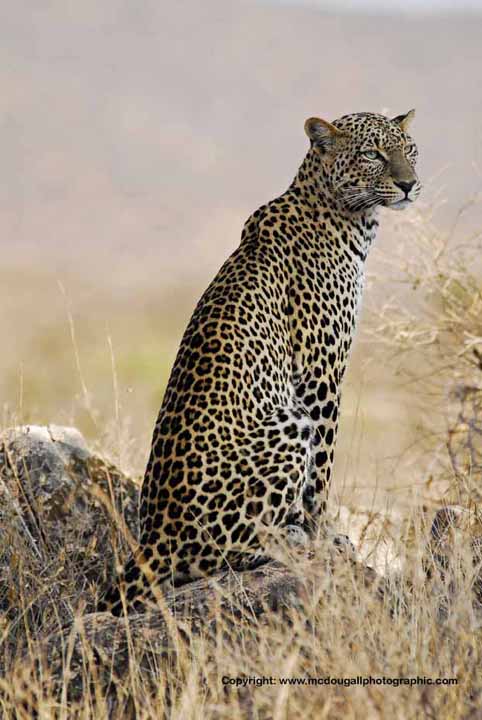
It took me 7 years to see my first Leopard, it was always the one animal that I didn’t see on my safaris. But then my luck changed. As you can see from the photographs, I have
now been fortunate enough to get many really good sightings and opportunities to photograph this beautiful cat. My first decent Leopard sighting was in Masai Mara. I was with clients when we stopped the vehicle on a hill, Isaac started to scan the trees with
his binoculars. I stood up and started to do the same, and then through the binoculars, a movement in a big sausage tree, no it couldn’t be I thought, but then it moved again. I said to Isaac that I thought I had found a Leopard, pointed to the tree and he
looked, but he couldn’t see anything, now this guys eyes are amazing and he can spot anything. We agreed that we had time to go and check it out, and as there was a track fairly close we drove back down the hill towards the tree. As we approached – still nothing,
closer and closer, and then as we got within 50 meters of the tree, there it was a beautiful male leopard laying on the branch of the tree, as it heard us approaching, it stood up and looked at us for a few seconds before it ran down the tree and off in to
the bushes. That was my Leopard and nobody could take that away from me. I can honestly say that the adrenaline that you feel from a sighting like that is amazing. After that sighting we had 4 further sightings of different Leopard, those clients on a 2 week
safari had seen more Leopards than I had seen in 7 years of coming to Africa.
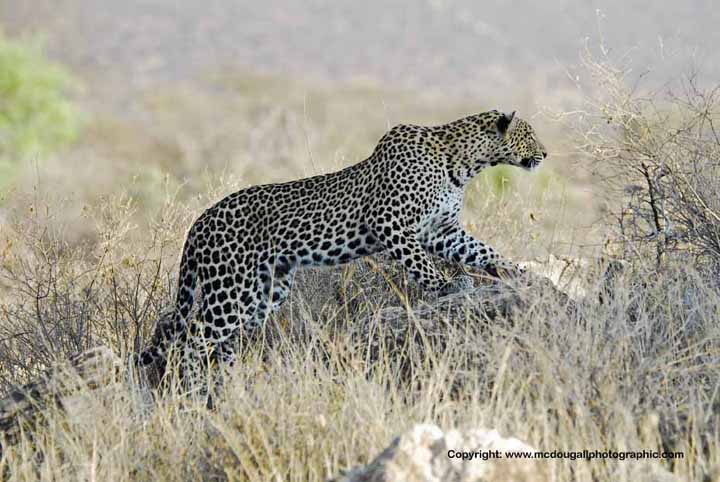
|
Adventure
|
Adventure
Elephant (Loxodanta Africana)
-Paul McDougall

The African Elephant is larger and has bigger ears than its Asian relative. Elephants can survive in virtually any habitat and are widespread throughout Kenya. Elephants are social animals and have a matriarchal society with herds of related females. Males
tend to be separate and are either alone or in male groups, their rank order is determined by seniority and reproductive condition. Female herds are made up of related individuals consisting of a mother and young with her grown daughters and their offspring.
Activity, direction and rate of movement are set by the matriarch, recognizable as the largest cow. Male elephants leave the maternal herd in adolescence (12-13 years) and after this never stay long with any cow herd. Elephants spend 16 hours a day feeding.
They can go several days without drinking, during which they can range up to 80 km from water, but drink and bathe daily by choice. An adult bull may drink 100 litres at a time and up to 227 litres a day. Elephants usually bathe after drinking, they roll and
wallow in shallows and may submerge completely in deep water. Elephants are very much contact animals. Family members often stand touching whilst resting or drinking. They lean and rub their bodies together, and often touch one another with their trunks. Elephants
vocal communication is limited to 4 different sounds but they vary the pitch, duration and volume which enables them to express a wide range of emotional states. After a 22 month gestation period females give birth to one calf. The Elephant was formerly widespread
south of the Sahara wherever water and trees occurred, but its range and numbers have shrunk as human population, development, and poaching have increased. Between 1970 and 1980 the population of East African elephants dropped by 80%. Elephants have more environmental
impact than any mammal but man. The beneficial effects (trails, wells, bringing food within reach of smaller browsers) are overshadowed by their destruction of trees, which has been spectacular in many African parks and reserves. In Tsavo, for example woodland
was transformed in to grassland, with the detriment to the elephants and many other species – especially black rhino. The root of the problem is the increasing confinement of elephants within parks. Tree destruction is a normal elephant activity and when spread
over a wide area contributes to habitat diversity and soil turnover. Elephants can be seen in Kenya in large numbers. They are particularly big in Amboseli where older elephants feed on the soft vegetation in the swamp areas allowing them to live longer than
the normal 60 years. Elephants in Samburu and Tsavo are generally a red colour, due to the dust that they cover themselves in. Another great place to see elephants in Kenya is in the Sheldrick Elephant Orphange in Nairobi, where baby elephants are taken in
as orphans and when they are old enough and well enough are re-introduced in to the wild of Tsavo NP.

I have again had many special moments with elephants; I have been in a vehicle with them so close you could touch them, I have been lucky enough to see large herds and even young calves. My most memorable has to relate to being charged though, it has happened
in Samburu, Tsavo East and Tsavo West – usually I manage to get in position to take a few photographs as the elephant runs at us, stops and throws its head and ears around in an act of defiance, mock charges are great. But one day in Tsavo East we were driving
on the dense thorny shrub road out of the park when we rounded a corner and encountered a huge bull elephant with one tusk. It took one look at us and charged, it soon became clear that this was not a mock charge. This bull meant business and although I managed
to take a few photographs as my good friend and business partner – Isaac reversed the vehicle at high speed down the road, I soon sat down and prayed that we would be able to keep ahead of it or it would loose interest. But it kept coming – we eventually rounded
a corner – giving us just enough time to turn the vehicle around and speed off, this bull followed us for a few km before we eventually managed to escape it. This was an old bull in musth, (characterized by highly aggressive behavior, accompanied by a large
rise in reproductive hormones – testosterone levels in an elephant in musth can be as much as 60 times greater than in the same elephant at other times). Not a good time to encounter it. We later found out after a very long diversion to the park gate that
this bull was also bad tempered as it had had a bad encounter with a safari vehicle a few months earlier. This is an unusual occurrence and not a normal safari experience, however it just reinforces that these are wild animals and you have to make sure that
you are with a qualified guide at all times.

|
Burning Issues
Non Sequiturs…
These comments arise from reading
The Jhurjhura Paradigm : Lessons from an absolute tragedy written by Russell Crisante Fernandes, who is one of many journalists both in India and abroad who have pegged stories about tiger tourism to the recent death of a tigress in Bandhavarh. While I
would agree that this event is an “absolute” – and, I might add, unnecessary – “tragedy” I do not understand the use of the term “paradigm” in this context. Furthermore to use this death to discuss tourism issues actually obscures the possibility of learning
useful lessons.
It is not only journalists who are creating this smokescreen. The director of India’s National Tiger Conservation Authority somewhat ingeniously commented in a recent interview “In Bandhavgarh, tiger tourism was seen at its extreme when a tigress was recently
killed by a vehicle. Shamefully, forest staff and local administration is involved. This when his own report of the incident says “there are enough arguments/evidences which strongly indicate” that two government vehicles were involved in the accident. It
is well known that the final deathblow was accidentally delivered the following morning by a forest department vehicle that had gone to check on the injured tigress. So am I missing something here? Forest officials in a protected area at night count as ‘tiger
tourism’….!
So why does this shocking incident generate so many articles about wildlife/tiger tourism? Tourism is an issue that certainly requires better management in some places but in relation to this event it is a complete red herring; it has eclipsed more serious
issues raised by the tragic consequences of inappropriate - and illegal - behaviour by members of the forest department and other officials.
Too many journalists have jumped on this story to write about the problems of tourism as though tourist behaviour had a bearing on the tigress’ death. Indeed if it were not for tourism, this would probably have been yet another death that the Forest department
managed to hide from public view. This exposure is perhaps the reason why some members of the forest department sound as thought they wish to ban tourism in some of our National Parks?
In most cases the journalists also seem to be writing without full information: for example, Bandhavgarh now has restricted routes so a rush to the meadows is much less of an issue. The Field Director also closely interacts with responsible tour operators there
and things are working better. In another article an entry ticketing system is suggested; this is already in place for most areas.
As with Panna, where department officials blamed researchers and everything other than themselves for the loss of over 40 tigers, forest officers in Bandhavgarh tried to pin the blame on tourism rather than examine their own failings. Fortunately the truth
came out, thanks largely to an exceptional Field Director and local support and interest.
But why are so many conservationists, journalists and sympathisers only looking at this tragic incident through tourism glasses. This misses the far deeper and more worrying aspects of the way our wildlife is managed. The security of large animals like the
tiger is almost entirely in the hands of the forest department; they alone have control of wildlife protection and refuse to share responsibility; they are reluctant to even beneficially use expertise from outside the system. But when things go wrong they
are neither accountable nor do they accept responsibility!
This one-model-for-all – and the model itself – need to be seriously re-evaluated and we should be reading articles that debate these pertinent questions raised by death of the Jhujhura female, not more comments on tourist behaviour. It was, after all, quickly
established that this death was not tourism related.
The inability to stem the tiger's slide to extinction is a far more complicated, profound problem; it is in large part systemic and therefore much harder to correct. An event such as this, where the forest department have directly – if accidentally - killed
one of the few remaining breeding females, could have provided the opportunity to raise and discuss these issues. This would be far more appropriate and useful than the endless tourism debates that deflect us from more creative conservation thinking.
Unless we come up with some solutions soon and force changes into the system, tiger tourism debates will anyway be a moot point.
Joanna Van Gruisen
Baavan – bagh aap aur van
|
Burning Issues
Coal based Thermal Power Project vs Wetland
-Dr. Susan Sharma
(with inputs from Saraswati Kavula and Internet news)
The people of Sompeta villages, in Srikakulam Disrict of AP State have been agitating against the proposed coal based Thermal Power project of Nagarjuna Construction Company (NCC), right from the day of the proposal and there was an overwhelming majority
opposing the project coming up in a WETLAND area, at Environmental Public Hearing.
The villagers have been making it clear that the thermal power project would fill the neighbouring fields and villages with ash and would also displace several fishermen families.
The petitioners from Sompeta pointed out that despite India being a signatory to the Ramsar International Convention on wetlands and the protection of wetlands comes under the ministry of environment and forests, the same ministry had cleared the project.
By claiming that three lift irrigation schemes survive on the water from these wetlands, they urged the court to quash the environmental permission given.
Social activist E.A.S. Sarma, former Union Power Secretary, said there was ample evidence to prove that the project site was in swamp land as several water courses passed through the site drawing into the sea.
There were mudflats and tidal action within the definition of Coastal Regulation Zone.
Telineelapuram bird nesting and feeding habitat was located in the vicinity of the project area.
Dr. Asad R. Rahmani of Bombay Natural History Society and Asha Rajvanshi of Wild Life Institute, after visiting Bhavanapadu and Sompeta, said the sites were located in ecologically sensitive areas due to several wetland systems.
The local people managed obtaining an Injunction order from the High Court in July 2010.
The District and State administration along with NCC have been trying to forcefully start the work in the area since April 2010. Large scale picketing by local people had been a deterrent, so when the Court Injunction came, the local struggle was vindicated.
However, things went terribly wrong in July, when the police resorted to firing, provoked by, hired hooligans. The ensuing violence made the Central Government review the Environment Clearance granted to the project, which was revoked.
Finally, the National Environmental Appellate Authority (NEAA) quashed the environmental clearance granted to the Nagarjuna Construction Company Ltd by the ministry of environment and forests to set up a thermal power plant at Sompeta village in Srikakulam
district.
The Centre had earlier cleared the NCC thermal plant along with three other plants that are to be set up in an area of 10,000 acres to generate 10,000 MW of power.
The NEAA faulted the Centre and said that the environmental clearance accorded by the ministry to the project was based on wrong information and was thus liable to be quashed.
“It is relevant to mention here that the...authority has no doubt that the area is a typical wetland of great ecological significance,” said NEAA, and added that it should not be used to set up a power plant.
NCC has been making arrangements for setting up a 2,640 mw thermal power project in Sompeta with an outlay of Rs 12,000 crore.
Sources:
http://www.business-standard.com/india/news/sunita-narain-seelight/402879/
see a video at
http://interceder.net/i/Sompeta
|
Did You Know ?
Unwitting help to species in trouble
Destruction of vegetation by humans may save an endangered bird from extinction, says S.Ananthanarayanan.
It needs no explaining that human activity is a threat to countless living species. One of the earliest acts of civilized humans was the clearing of land for cultivation. This started the process of habitat destruction, which is still the main threat to survival
of biodiversity. The rapid invasion, by humans, of natural habitats during the last century has led to migration and partial extinction of larger animals and widespread extinction of smaller species and microbes that thickly vegetated areas supported. In
recent times, people have become sensitive to what humans are doing to the environment and success in saving endangered species has become a measure of how effective the drive to save habitats has been.
In this context, the report by the University of East Anglia UK, in the journal Animal Conservation, that human activity has had a beneficial effect on the population of a critically endangered bird of northern Cambodia is greeted with pleasant surprise.

The white shouldered ibis
Ibises are long legged wading birds, with pointed bills that curve downwards. They inhabit lakes, marshes or slow flowing streams, sparsely wooded lowland forests, wet grasslands or sand-bars in wide rivers. They graze in groups, turning the mud for snails
or slugs and usually nest in trees, often along with other bird species. The white shouldered ibis is a large bird, at 75-85 cms long, has dark plumage, pale neck and a black, bald head. It also has a white patch on the inner forewing and hence its name. Of
late its population has been drastically dwindling – perhaps mainly because its living spaces are being drained for cultivation or for livestock grazing or for construction. Loss of secure feeding and breeding spaces and disturbance are considered the main
reasons for falling numbers but the exact reasons are yet not known. The great part of the surviving birds are now found in Cambodia. There are a few in Indonesian Borneo but the species is extinct in Thailand and Vietnam. It may just be found in southern
Laos and perhaps in Myanmar, but the fall in numbers has been drastic and in 2001, Birdlife International, a global partnership of conservation organizations, has estimated the total population to be as low as 250!
Such a low population is considered by many to be below the critical number needed for a species to survive, except for elaborate, but challenging conservation strategies. Conservation of the tiger, for instance, has large funding and extensive protected forests,
but this is in the context of population of 3,400 to 4,500. Numbers of the African lion are over 30,000 while the Asian lion is considered highly threatened with about 350 in the Gir National Park in Gujarat. The tiger is considered ‘endangered’ and the
African lion is ‘vulnerable’. But the white shouldered ibis is ‘critically endangered’, or ‘facing extremely high risk of extinction in the immediate future’, and is in the ‘Red List’ of endangered species of the International Union for the Conservation of
Nature (IUCN).
Welcome discovery
In Nov 2005, staff of Birdlife International and Cambodia’s Wildlife Protection Office made a sensational discovery of a flock of 70 white shouldered ibis, the largest number seen together since the conservation programme had started, in the Siem Pang district
in Cambodia. A year later, BirdLife and WPO staff recorded a staggering 108 White-shouldered Ibis at 2 sites in western Siem Pang District. At the first site 28 birds were recorded in trees at a forest wetland of the kind that sustain these birds. Later the
same day, another 80 White-shouldered ibis were counted coming into roost in the evening, some distance away.
That such good numbers of the birds could be found in Siem Pang, while the bird was practically not seen anywhere else has put the spotlight on this district, as important for conservation, lest the fragile ecology of the area be destroyed, at the cost of the
birds and also the human inhabitants, whose lives depend on the forest and the wetlands. In the meantime the University of East Anglia undertook a study, funded by the Royal Society for the Protection of Birds and the Natural Environment Research Council,
into the reasons for the decline of the birds’ numbers.
The UEA researchers made the counter-intuitive discovery that apart from preserved wetlands, it was the traditional farming methods of the native inhabitants of the area that helped the white shouldered ibis multiply and thrive! The researchers found that the
birds preferred to graze in open and accessible areas with low vegetation and bare soil. This could be because it makes it easier to find prey, is convenient for take-off and landing, and provides no cover for predators. In areas that are overgrown with vegetation,
the traditional farming methods are to use the land for grazing and to practice a method of burning the part of the forest that grows under the canopy of trees (called the understorey), which creates the habitat that is suitable for the birds.
"Our findings show that this critically endangered species is largely dependent on the local farmers for their survival," said lead author Hugh Wright, of UEA's School of Environmental Sciences. "This is a fascinating outcome as we tend to assume that human
activity always has a negative impact on the natural world."
Western Siem Pang, where these populations of ibis have been found, is as yet an unprotected site and is under threat of forms of development that would wipe out both the birds as well as the indigenous inhabitants. The UEA team is hopeful that their intervention
would result in Government action to save the region.
[the writer can be contacted at simplescience@gmail.com]
|
Did You Know ?
Unwitting help to species in trouble
Destruction of vegetation by humans may save an endangered bird from extinction, says S.Ananthanarayanan.
It needs no explaining that human activity is a threat to countless living species. One of the earliest acts of civilized humans was the clearing of land for cultivation. This started the process of habitat destruction, which is still the main threat to survival
of biodiversity. The rapid invasion, by humans, of natural habitats during the last century has led to migration and partial extinction of larger animals and widespread extinction of smaller species and microbes that thickly vegetated areas supported. In
recent times, people have become sensitive to what humans are doing to the environment and success in saving endangered species has become a measure of how effective the drive to save habitats has been.
In this context, the report by the University of East Anglia UK, in the journal Animal Conservation, that human activity has had a beneficial effect on the population of a critically endangered bird of northern Cambodia is greeted with pleasant surprise.

The white shouldered ibis
Ibises are long legged wading birds, with pointed bills that curve downwards. They inhabit lakes, marshes or slow flowing streams, sparsely wooded lowland forests, wet grasslands or sand-bars in wide rivers. They graze in groups, turning the mud for snails
or slugs and usually nest in trees, often along with other bird species. The white shouldered ibis is a large bird, at 75-85 cms long, has dark plumage, pale neck and a black, bald head. It also has a white patch on the inner forewing and hence its name. Of
late its population has been drastically dwindling – perhaps mainly because its living spaces are being drained for cultivation or for livestock grazing or for construction. Loss of secure feeding and breeding spaces and disturbance are considered the main
reasons for falling numbers but the exact reasons are yet not known. The great part of the surviving birds are now found in Cambodia. There are a few in Indonesian Borneo but the species is extinct in Thailand and Vietnam. It may just be found in southern
Laos and perhaps in Myanmar, but the fall in numbers has been drastic and in 2001, Birdlife International, a global partnership of conservation organizations, has estimated the total population to be as low as 250!
Such a low population is considered by many to be below the critical number needed for a species to survive, except for elaborate, but challenging conservation strategies. Conservation of the tiger, for instance, has large funding and extensive protected forests,
but this is in the context of population of 3,400 to 4,500. Numbers of the African lion are over 30,000 while the Asian lion is considered highly threatened with about 350 in the Gir National Park in Gujarat. The tiger is considered ‘endangered’ and the
African lion is ‘vulnerable’. But the white shouldered ibis is ‘critically endangered’, or ‘facing extremely high risk of extinction in the immediate future’, and is in the ‘Red List’ of endangered species of the International Union for the Conservation of
Nature (IUCN).
Welcome discovery
In Nov 2005, staff of Birdlife International and Cambodia’s Wildlife Protection Office made a sensational discovery of a flock of 70 white shouldered ibis, the largest number seen together since the conservation programme had started, in the Siem Pang district
in Cambodia. A year later, BirdLife and WPO staff recorded a staggering 108 White-shouldered Ibis at 2 sites in western Siem Pang District. At the first site 28 birds were recorded in trees at a forest wetland of the kind that sustain these birds. Later the
same day, another 80 White-shouldered ibis were counted coming into roost in the evening, some distance away.
That such good numbers of the birds could be found in Siem Pang, while the bird was practically not seen anywhere else has put the spotlight on this district, as important for conservation, lest the fragile ecology of the area be destroyed, at the cost of the
birds and also the human inhabitants, whose lives depend on the forest and the wetlands. In the meantime the University of East Anglia undertook a study, funded by the Royal Society for the Protection of Birds and the Natural Environment Research Council,
into the reasons for the decline of the birds’ numbers.
The UEA researchers made the counter-intuitive discovery that apart from preserved wetlands, it was the traditional farming methods of the native inhabitants of the area that helped the white shouldered ibis multiply and thrive! The researchers found that the
birds preferred to graze in open and accessible areas with low vegetation and bare soil. This could be because it makes it easier to find prey, is convenient for take-off and landing, and provides no cover for predators. In areas that are overgrown with vegetation,
the traditional farming methods are to use the land for grazing and to practice a method of burning the part of the forest that grows under the canopy of trees (called the understorey), which creates the habitat that is suitable for the birds.
"Our findings show that this critically endangered species is largely dependent on the local farmers for their survival," said lead author Hugh Wright, of UEA's School of Environmental Sciences. "This is a fascinating outcome as we tend to assume that human
activity always has a negative impact on the natural world."
Western Siem Pang, where these populations of ibis have been found, is as yet an unprotected site and is under threat of forms of development that would wipe out both the birds as well as the indigenous inhabitants. The UEA team is hopeful that their intervention
would result in Government action to save the region.
[the writer can be contacted at simplescience@gmail.com]
|
Eco-travel
-Russell
Crisante' Fernandes
As we look towards the heavens for some respite from the heat and dust of the blazing Indian summer, it also means that most wildlife reserves across the country will close
for the monsoons for a time frame of anywhere between 3 to 4 months. And while it's time to put away those magnificent lenses and cameras that we use to cover our faces on profile pictures, it's perhaps time to review the situation.
During the past season, the debate over tourism within Tiger reserves reached a new crescendo. We heard both sides cry themselves hoarse over what is an agreeable middle path. It remains clear that neither side will get their way. The romantic conservationist
that wants to see every person barred from entering wildlife reserves will sooner or later have to come to terms that tourism is here to stay. And the opportunistic tour operators that will have to realize that pulling a dry udder may get you something besides
milk. Both sides are leaving the common person confused on whether they are contributing towards or raping the ecosystem they are visiting.
An email exchange with Dr. Prachi Mehta threw up some very interesting insights on how the African Model of tourism could be employed within Indian reserves. Since I have never visited the beautiful continent, I cannot comment much on the topic first hand.
But I will provide some details on different visitor models within India across the different reserves that I have visited and hopefully, it can lead to a more exhaustive debate on which ones can be implemented across the country at some stage.
The most common mode of entering wildlife reserves as a tourist is by hiring a 4wd, the most popular model being the Maruti Gypsy. It is a photographer’s dream vehicle as one can stand up or hang out of the sides with ease. The positioning of the seats also
makes it convenient to move from one row to another, depending on the view or angle of a photograph that is desired. It is a mode of transport that is prevalent in Bandhavgarh, Kanha, Kaziranga, Gir and Ranthambhore, to name a few.
The one mode of transport that I am dead against, although this may not endear me to many, is entering by private vehicle. Invariably, you will see people stepping out of their vehicles as the side door frames and hard top are not convenient for photography
or even a decent look at the animals or birds. Furthermore, another subject of contention is the ability of the driver to understand a relatively unknown terrain as compared to a hired local that knows the limits of his vehicle and the landscape a lot better.
Lastly, there is less incentive for a hired driver to break the rules as it could invite suspension of his license and there is no stronger motivator than the potential loss of income. How effectively that deterrent is used is another subject, but to me it
still remains the lesser of the 2 evils.
Looking at the Ranthambhore model, the process of allotting seats for entry into the reserve lies with the Forest Department. The early birds get the best seats in a Maruti Gypsy that accommodates 6 people besides the driver and the guide. One those fill up,
the rest of the seats are sold on Canters which can hold anywhere between 20 to 24 people. This model ensures proper utilization of space within a vehicle and limits the entry of the number of automobiles within a park. Over the years, images of Ranthambhore's
small forest roads across the hilly terrain being packed with Gypsys and Canters full of tourists trying to catch a glimpse of a passing Tiger has led to some fumes and the occasional case of bad gas. But it is a model that needs to be studied better, as apart
from the unattractive traffic jams that take place occasionally it is a more sensible approach towards reducing carbon footprint within a protected area.
If one moves further South towards Bandipur, there is a similar model being run by the forest department. While a limited number of operators are allowed to take guests into the reserve in Gypsys, there is also a bus service that is run by the Forest Department.
This run is limited to the main roads and accommodates the crowds that are for various reasons not as keen or able to make the 4 hour trip by Gypsy. The crowd control within these 'Joy Rides' is appealing as the atmosphere is more like a college party on spring
break, sans the bikinis. However, this model that has its advantages since it provides an opportunity to keep a large amount of the crowd on a limited run and have them exit the reserve as soon as it is completed. It would be counterproductive though if an
equal number of Bus rides were provided for Gypsys taken off, as the carrying capacity of the reserve needs to be measured not just in vehicular impact but also in pure numbers of tourists.
Other debatable methods of managing Tourism have been practiced in the Dikhala zone of Corbett Tiger Reserve, where entry is limited strictly to visitors that have a permit to stay in one of the sought after Forest Rest Houses or to those that have availed
of the Forest Department’s canter ride. A belated debate has arisen about the viability of the Dikhala complex being present within a sensitive zone, so it can be assured that such a model may not be repeated within any of the other parks. Corbett, one of
our flagship parks, has been in the news for all the wrong reasons of late and one hopes that all stakeholders can work out a solution that not only benefits the park, but sets a roadmap for others across the country.
The only common thread between all the wildlife reserves across the country is perhaps the deplorable behavior of most of the visitors and the lack of will power to curb it. It was shameful to see a tourist actually spit at a guide for not showing him a Tiger
at Corbett (Where else?) and then wonder why he was being reported for ‘Exposing a scam’. For all the criticism they may have received in the past, the management at Gir are doing a commendable job when it comes to monitoring the behavior of their guests and
are not shy of collecting the fines that will ultimately serve a dual purpose of deterrence and filling coffers the right way. Perhaps other visitors to Gir may have a different take based on their experiences, but it is critical that the enforcement of rules
is not an afterthought.
Whichever way one looks at it, Tourism has it’s pros and cons. The debate can either go on ceaselessly about it’s viability or we can look at a solution that benefits primarily the wildlife and the communities that live around it. Personally, arguments from
both sides have probably done more disservice to the cause of the respective lobbies rather than strengthen their position. Conservation as a whole is failing in too many spheres to put all the blame solely at the doorstep of Tourism. And Tour Operators are
doing too little to convince the nation that their intentions are anything other than material. The time has come to put personal agendas and egos aside, even if temporarily, and concentrate on solutions instead of slogans.
|
Events
Hadoti Monsoon Extravaganza
August 6 at 11:30am - August 8 at 2:00pm
Location Bundi Region, Rajasthan, India
Hadoti- Rajasthan-India…Picturesque, Primitive, Enchanting and Magnificent…come explore the unexplored.
The town of Bundi is situated 36 km from Kota and 206 km from Jaipur and in the heart of Rajasthan. Bundi has been rightly termed as the queen of Hadoti. Bundi has fascinating, historical monuments, natural beauty, scenic dams & ponds, wild forests fairs and
festivity. The Bundi School of painting is world famous and Bundi Utsav is celebrated annually. Bundi offers various ways to experience its magnificence.
Anything from adventure tourism, archeological tourism, cultural tourism, eco tourism, heritage tourism, to spiritual tourism and wildlife is offered there and around.
The country around Bundi is a lot like the outback - desert and scrub with watering holes and canyons. Native people or 'adivasis' had been coming here for centuries to make offerings and perform rites.
The Royal Escape invites you all to explore this pre-historic and medieval flavor that this tranquil Bundi region has in store. In a true sense this place is just less travelled and unexplored and defines the ardent travelers’ quest.
BUNDI WITH KUKKI
The entire tour would be escorted by Mr. Om Prakash alias Kukki. Kukki is an amateur archaeologist with an extra ordinary passion and infectious positive energy hails from the Bundi region. Two decades of his life have been spent exploring the hills and river
banks around Bundi. Without any fundings or governmental support he has found evidence of unknown civilizations. Prehistoric rock paintings, weapons of stones, shards of pottery, utensils made out of terracotta and coins from various dynasties that ruled in
India, constitute his vast wealth of findings. It is commendable for a man who is educated till class 8.
Brief Itinerary: FIXED DEPARTURE (Aug 6, 2010 – Aug.8, 2010)
Day 1 Aug 6, 2010): Guests will be picked up from Kota (36 kms and a convenient railhead) or Jaipur (206 kms) and transferred to a hotel in Bundi. After lunch take a tour along the Bundi town visiting Taragarh Fort, The Bundi Palace, Chitrashala, Garh Palace,
Chhattar Mahal, Nawal Sagar, Sukha Mahal and the beautiful Jait Sagar Lake. Dinner and overnight at the hotel.
Day 2 (Aug 7, 2010): After breakfast, take a full day jaunt to places like Golpur, Abhaypura, Garrada, Bhimlat Nala, Bijolia (Mini Khajuraho) etc. for long necked vulture sighting, pre-historic painings and caves, medieval age temples, water bodies, canyons
and cascading spring waterfalls, wild life sighting, nature appreciation. Traditional lunch enroute. Back to Bundi by evening. Dinner and overnight at the hotel.
Day 3 (Aug 8, 2010): After breakfast a short excursion to Rameshwar. Rameshwar hosts Rameshwar Cave Temple where the Shivling is naturally made from lime fossils and a small fort with an interesting history. Back to Bundi. Transfer to Kota/Jaipur after lunch.
Tour ends.
Please feel free in contacting me for further queries or booking:
SANJIV BHATNAGAR
Mobile no. +91-98290 85811
The Royal Escape
(Offbeat travel facilitators)
A-12, Jamna Nagar, Sodala, Jaipur-302 006 (Rajasthan - India)
E mail: royal.escape@gmail.com
www.facebook.com/sanjiv.bhatnagar.jaipur
Photo Exhibition of Jhurjhura Tigress on World Photography Day
August 19 · 12:00pm - 7:30pm
Location Bhopal
August 19th is a very special day for photographers around the world. It’s on this very day, that the invention of photography was publicly announced in Paris, 1839. Since this occasion, the day has been celebrated as World Photography Day.
On August 19th I request every member of the group Professional, amateur photographer...s to send Pictures of Jhurjhura and ask your friend to send the Pictures of Jhurjhura Tigress and share it in the Exhibition which is being organized by the Group.
Share your grief and anger with the world by sending Photographs with names and message and mail at tigrgressmadhyapradesh@ gmail.com as Justice has not been given to Jhurjhura Tigress till Date .
On the 18 May 2010 the Murder of Jhurjhura Took place. The vehicles entered Bandhavgarh Tiger Reserve ILLEGALLY AT NIGHT and the Jhurjura tigress, mother of three small cubs, was hit by one them and severely wounded.
The Jhurjura tigress leaves behind 3 small cubs, approximately 6 months old, that are now orphaned and who were totally dependent on their mother.
Born in April 2002 to the Chakradhara tigress-sired by B2 and mortally wounded by humans on 18 May 2010
MESSAGES, PAINTINGS,DRAWING CAN BE PICTURED AND SENT
tigressmadhyapradesh@gmail.com
Agumbe Photography workshop
August 21 at 7:00am - August 22 at 8:00pm
Location Agumbe, Karnataka
An expedition in to the heart of western ghats, the thick evergreen forests which receive the heaviest rainfall in India. Spend 2 days in the rainforests of Agumbe. Here's your chance to photograph some of the most beautiful waterfalls, landscapes, forests,
mammals, birds, reptile and amphibians ever seen.
Camp at India's first Rainforest research station the ARRS (Agumbe Rainforest Research Station).
The cost of this expedition ex-bangalore is Rs Rs 9600/- and includes :
* Transport from Bangalore and back in a deluxe bus
* Accommodation on twin-sharing basis in tents. Tents are pitched about 100m from the base camp in the forest to provide a unique experience. They are pitched inside permanent platforms raised above the ground. Sleeping bags, mats etc. are provided
* All meals, local guide/tracker charges, Leech socks (provided in monsoons)
* Transport in private vehicles to different places around Agumbe
Excludes:
* Any kind of personal expenses
* Medical Insurance
* Purchases made outside
More information here: http://amoghavarsha.com/workshops/agumbe
Now a poisonous trip from 100miles.
The boundule bikers for a bike trip to Bishnupur, Jhapan Festival, The Festival for SNAKES. The most unique festivals celebrated in West Bengal, dedicated to Goddess Mansha, the Goddess of Snakes.
West Bengal is famous for its rich cultural heritage and the uniqueness of its traditions.
...
Jhapan festival , observed on the last day in the Shraban month (17 August, 2010) in Bengali calendar, is largely of tribal origin. There are several folk tales dedicated to Goddess Manasa and most of them extol of the need for man to live in harmony with nature.
Praying for good rainfall and enhancement of the fertility of their land. As West Bengal has an agro-based economy, the tradition is being carried out for a long time here.
This celebration is considered to be auspicious for the coming harvest season. The festival is celebrated with local fairs and other festivities, like stage shows of local plays and snake shows by local snake charmers.
Accommodation:Twin Sharing.
Charges:Rs. 3000.00 per head + own bike arrangements and fuel.
Non bikers are also welcome to join us at Bishnupur. (Same Charges apply.)
Ask for separate car / train arrangements from Kolkata.
Read more at
http://www.facebook.com/event.php?eid=108136889240645
Events organized by BNHS
Nature Trail at Silonda
August 8 · 7:30am - 11:00am
Location Sanjay Gandhi National Park
This trail in the Sanjay Gandhi National Park, Borivli not usually accessible
without official permission, is a pleasant walk through bamboo groves. With the monsoon in full force, the trail will be enjoyable. This trail leads through fine forest and shrub and crosses several rivulets and streams that are now roaring wild. Excellent
nature-watch opportunities. Meeting Point: Members to meet at the SGNP main gate (please take you...r ticket for entering the park) at 7.30 a.m. Charges: Rs. 50/-(Non–member Rs. 100/-) Group Leaders: Mr. Sanal Nair and Mr. Vandan Jhaveri. Booking: On the spot.
GREAT INDIAN BUSTARD SANCTUARY- NANNAJ
August 27 at 8:00am - August 29 at 5:00pm
Location NANNAJ- Solapur
Nannaj is situated just 20 kms from Solapur. Best place to see India’s most endangered bird, Great Indian Bustard. Nannaj grassland has variety of birds like Larks, Pipits, Sandgrouses, Eagles, Harriers and mammals like Indian Jackal, Wolf and plenty of Black
Bucks. Group Leader: Mr. Sujit Narawade and Mr. Asif Khan Camp Charges: Rs. 3000/- (includes food, accommodationand local travel) Reporting: Solapur Station at 8.00 a.m. o...n Friday morning. Members are
advised to take overnight bus or train that reaches Solapur. Camp will conclude on Sunday at 5.00 pm.
How to reach Solapur: From Mumbai, Siddheshwar Express leaves at 22.35 hrs and reaches Solapur next morning around 06.50 hrs. While returning to Mumbai Husain Sagar Express leaves Solapur at 20.50 hrs (10 mins halt) and reaches Mumbai next morning at 05.30
hrs Siddheshwar Express starts from Solapur at 22.45 hrs and reaches Mumbai next morning at 07.00 hrs Participants will be dropped at Solapur Station at 17.00 hrs.
Note: - Room sharing will be separate for male and female participants.
Booking: Call at Hornbill House 22821811See
RAJMACHI TREK
August 28 at 6:30am - August 29 at 8:30pm
Location RAJMACHI
Situated on the crest of the Sahyadris, Rajmachi is popular among trekkers.
Here, there are two beautiful peaks namely ‘Shrivardhan’ and ‘Manoranjan’. Shrivardhan is at the height of 3000 ft., while the strongly fortified Manoranjan is at a height of 2700 ft having 3 doors, several water tanks and a huge cave. This area is good for
butterflies, birds, wild flowers, reptiles and
amphibians. Rajmachi is one of the best places to vis...it during monsoon. Grade: Difficult. Duration of Trek: Four hours for one way climb. Group Leaders: Mr. Nikhil Bhopale and Mr. Vandan Jhaveri Booking: Call at Hornbill House 22821811 Charges: Rs. 1300/-.
Meeting Point: Bus will leave at 6.30 a.m. from Dadar, (near Chandu Halwai) 6.50 a.m. from Chembur, (near Diamond Garden) and Vashi Junction at 7.10 a.m. Participants will start returning after lunch and will reach Mumbai by late evening on Sunday Note: Stay
and food is arranged with the villagers. Please carry your own bedding or sleeping-bag, and make your provision for breakfast and lunch for the first day. Carry water. Come in proper footwear for trekking. Be prepared for heavy rains.
Events organized by BNHS ( Advance booking in August)
1. An Autumn Trek in the Himalaya
( Book in advance)
October 16 at 9:30pm - October 23 at 8:30pm
Location Dodital- Uttarakhand
Dodital is a high altitude lake in Uttarakhand at 3,024 m. This crystral clear lake is in the midst of thick forest of Oak, Rhododendron, Fir and Deodar. Another name for this lake is Dhundital meaning Lake of Ganesha. One side of the lake is guarded by a high
ridge called the Darwa Top, which gives a panoramic view of high peaks of Garhwal. Good opportunity to see the region’s rich Himalayan flora and fauna. Traditionally Dodit...al route has been frequented by nomadic herdsmen for grazing their livestock, and
by pilgrims on the Gangotri-Yamunotri route. Perfect time to see Himalayan Monal, Koklas Pheasant, Chestnut-bellied Rock Thrush, Bearded Vulture and butterflies like Queen of Spain, Blue Apollo, Painted Lady, Indian Red Admiral and lot more.
Dates : 16th -23rd October 2010
Trek Grade : Difficult. Physical fitness is necessary for the trekking during the camp, ponies might not be available. Luggage will be carried by the porters.
Meeting Point : Birla Temple, Cannaught place, Delhi at 9.30 pm on Saturday,
16th October 2010. Though we will return on 23rd October kindly book your overnight stay at Delhi and return ticket for 24th October.
Cost : Rs. 17,000/-
Group leaders : Mr. Nikhil Bhopale & Mr. Asif Khan
Accommodation : twin/ triple sharing
Registration : Call at Hornbill House 22821811.
2. PARAMBICULAM- WILDLIFE SANCTUARY
(Book now)
October 6 at 7:30am - October 8 at 4:30pm
Location Parambiculam, near Kochi- Kerala
One of Kerala’s premier wildlife reserves is situated in the Annamalai Hills, south of the Palghat Gap in the Western Ghats. The 285 sq km stretch of thick forest has several rivers, including the Parambikulam, the Sholayar and the Thekkedy. Thickly forested
with stands of bamboo, sandalwood, rosewood and teak. Here you can see the famous Kannimari teak tree, the largest in Asia. Fauna includes tigers, leopards, wild dogs, sloth... bears, elephants, wild boar, barking deer, spotted deer, langurs and macaques.
Parambikulam is also home to Kerala’s largest population of gaur. Besides these, civet, chevrotain (mouse deer), pangolin, crocodile, jungle cat, porcupine and some 140 species of birds are found in the sanctuary.
Accommodation : Dormitory (basic amenities)
Charges : Rs. 6500/-
Meeting Point : Coimbatore Jn railway station at 7.30 hrs,
drop back to Coimbatore Jn Railway station at 16.30 hrs
How to Reach : Coimbatore Express (1013) Starts from Kalyan Jn at 23.18 hrs and
reaches Coimbatore Jn at 6.30 hrs
Return : Kanyakumari Mumbai Express (6382) reaches Coimbatore Jn at 18.00 hrs (5 mins halt)
and arrives in Mumbai at 4.50 hrs
Registration : Call at Hornbill House 22821811.
|
Events
Event at Pune
Dear Friends,
Tiger Action Force cordially invite you to a Conservation Event to celebrate the International Year of Bio-Diversity.
The event will be held on Saturday, 10 July 2010 and Sunday, 11 July 2010 at Balgandharva Art Gallery, JM Rd, Pune.
See you at the event!
The details of the event can be found below:
Event Theme: Celebrating International Year of Bio-Diversity
Display of more than 150 photographs showcasing India's rich bio-diversity plus a section to highlight problems to wildlife caused because of internal fragmentation of forests by roads and highways. A series of lecture’s to raise awareness about India's bio-diversity.
Event Details:
Inauguration: Saturday, 10 July, 10:00AM
Lecture on India's Biodiversity: Saturday, 10 July @10:30AM.
Lecture on Wildlife Conservation: Sunday, 11 July @10:30AM.
Added Attractions (for sale): Mogya Handicrafts by Tiger Watch, Artificial Nests by Tiger Action Force, Eco-Friendly bags by Protecterra Ecological Foundation, Nature / Wildlife related books.
Please Note: The photo exhibition will be open from 10 July, 10:00AM to 11 July, 8PM.
Contact Mridula 9545940119
Contact Gaurav 9922414523
Events at Mumbai
Dear Friends,
After the scorching heat of summer, we all have welcomed the monsoon with great joy and enthusiasm. Nature is at its best transformed from brown, parched look to fresh green face. With the first showers of rain variety of lilies, yam, mushrooms have sprout
out of the earth spreading joy to all. Insects, frogs and reptiles have wake up from their long sleep and the forest is full of musical sounds. Not to forget the wonderful streams are bubbling with the flowing water. Everyone has a relishing time throughout
monsoons, visiting wildlife this time is like each and every leaflet telling stories of wildlife wonders.
To celebrate this drama in nature, CEC is offering interactive and thematic nature trails on weekends.
Venue:
ConservationEducation Centre, Goregaon (East)
Saturdays
Timing:
3:00p.m. - 6:00 p.m.
Date
Theme
24 July 2010 Monsoon Flora
14 August 2010 Fungi
21 August 2010 Medicinal Plants
28 August 2010 Insects
Sundays
Timing:
8:00 a.m. - 11:00a.m.
Date Theme
25 July 2010 Monsoon Flora
8 August 2010 Herpetofauna
15 August 2010 Medicinal Plants
22 August 2010 Insects
Fees: Rs.200/- per person per theme
For
queries: write to us at
cecbnhs@... OR call us at 9223513425, 28421174, 22837615, 28402946
So come rendezvous with nature on the tantalizing trails @ CEC
Regards,
Priti Choghale
Senior Education Officer
BNHS Conservation Education Centre
Near Film City, Goregaon (E), Mumbai - 400065,Maharashtra, India.
Tel:91-22- 28402946/28421174
Mobile: 9223513425 / 9323738622
Website: https://cecbnhs.wetpaint.com/
|
Forest and trees
(An extreme view of tree plantation & a small example of practice)-Part I
-From "The Butterfly Diaries"

Its that time of the year when civic and nature organisations in India wake up from their slumber and begin to consider tree-planting yet again. Though this is an annual affair,
strangely India’s forest cover and biomass doesn’t seem to improve even where these activities are being carried out.
Typically, tree plantation begins with the collection of whatever dismal fare in saplings the forest department is willing to provide, followed by the desultory digging of holes and careless planting of trees. This activity, concluded in a couple of days in
the early monsoon, will be followed by a relapse into torpor. The final act is, of course, the appearance of a plague of self-publicised reports in the papers.
School-children plant trees as they take part in a "One day - One lakh plantation programme" on the outskirts of Hyderabad. Is this the way we should plant trees?

Over the next few months though, the thousands of saplings, thoughtlessly planted, are exposed to the harsh Indian environment accompanied by the complete neglect by the tree-planters.
The subsequent perishing of the year’s plantation by the end of the next summer (except for the minuscule few which by God’s grace actually manage to survive) should come as no surprise. And in the hallowed traditions of Hindu religious ideology, the kaal-chakra
turns to bring us back to tree-planting season again. Paradoxically, all of us feel good having participated in a worthwhile activity even though it is conducted so abominably.
Not all tree-planting is conducted this way. People plant carefully selected saplings to enhance their gardens and backyards. Some corporates do succeed in giving strikingly good tree-scapes and gardens to their campuses. Children all over carry out this activity
with the single-minded intensity of play. To them it is something well worth doing. A few civic organisations do exceptionally fine jobs of restoring plant cover and biodiversity to their favourite haunts. But these are a drop in the ocean when compared to
the morass of carelessly contrived tree-plantation schemes in our country.

The Pipal or Bo tree (ficus religiosa) (Image: Eric Guinther)
Hindu culture gives trees (or plants) an importance of their own. Planting a tree is said to be more fruitful than having a hundred sons. A number of trees figure in our pantheon
of objects worthy of worship – the Peepul Tree (Ficus religiosa) and Banyan (Ficus benghalensis) come immediately to mind. The Kalpavrisksh which fulfils the wishes of all, the Bo tree under which the Buddha gained enlightenment, the Aak (Calotropis spp) tree
under which Emperor Akbar was born are some examples of trees in our culture. Fragrant flowers are offered to our Gods in obeisance. Certain plants are associated with our deities – the “krishna” and “laxmi” varieties of Tulasi (Ocimum sanctum) and the Lord
Dattatreya’s fondness for the Umbar or Audumbar (Ficus racemosa) spring to mind.
Kalpataru, the divine tree of life. The wish-fulfilling bountiful tree is guarded by mythical creatures Kinnara and Kinnar. This bas-relief is the adorned wall of Pawon temple, an 8th century small shrine between Borobudur and Mendut temple, Java, Indonesia.
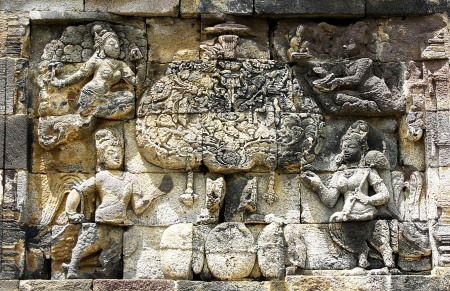
Above image by Gunkarta. Source : Wikipedia.
Yet, we tend to approach tree-plantation with less finesse than a three year old child.
Perhaps it is semantics. The term “tree plantation” implies that our job is just to plant – it’s nature’s business to do the rest. The truth is, if we want to really make a
difference, the business we should be in is “growing trees” not “planting trees”. That implies a whole lot more than partial burial of an juvenile plant in unprepared ground. The successful planting and growing of trees is not a rapid paced activity but takes
an enormous amount of time and effort. Accordingly, there is a need for thinking deliberately, planning and careful preparation before we get down to the plantation which is just one event in the long process of growing trees.
Maybe the reason is selfishness. In this materialistic world, there is nothing to be gained by labouring for unborn generations. In such a view point, tree plantation would
be meritorious only as a means for acclaim (for publicity and public adulation), getting rich (through corruption or by marketing one’s products) or as an indicator of performance (X planted more trees in his tenure than Y).
"Monocultures are ecological deserts. Tree plantations are not forests.
Another malaise in tree-plantation is mono-culture. It could be that most people do not realise that the planting trees of a single species, termed as mono-culture, is harmful. But the gaurdians of Indian forests should know. Invasive
trees take away more from our environment than their successful propagation. Yet it is the bureaucratic forces which have championed the cause of ecologically harmful exotic trees which grow quickly - such as Australian Acacia (Acacia auriculiformis), Kubabul
(Leucaena leucocephala) or the various forms of Eucalyptus – or even worse, the highly poisonous Jatropha curcas, purportedly for “bio-diesel”.
Jatropha curcas, the Physic Nut tree, is a poisonous, semi-evergreen shrub or small tree. Useful for biodiesel, it is ecologically useless.
It is the banal attitude towards tree plantation which reduces such a worthy activity to a pedestrian one that irks me greatly.
As far as growing trees is concerned, my own humble opinion can be summed up as :
Tree-planting is a craft. We should be “tree-smiths” – carefully crafting the environment in the manner that we make a Japanese garden, with each tree carefully chosen for effect, harmony, utility, importance, i.e. for a purpose. Growing trees is not meant
to be hedonistic or banal. It must be done spiritually – a kind of zen activity. It must be done to completeness. And the result must be healthy trees that give us the benefits we hoped for and more.
For that, we really need to know and love our trees.
-To be Continued......
|
Forest and trees
Crafting India's Landscapes-Part II
-The Butterfly Diaries
I love to recall the feel of the bark and leaves of the Banyan, the smell of flowers of the Neem (Azadiractha indica) or the crushed leaves of the Kadi Patta (Murraya koenigii) , the visual extravaganza that the Laburnum (Cassia fistula) provides in summer.
Once we get a feeling of love and appreciation of trees, then and then alone can we make quality choices about the best or most appropriate shrub or tree to be chosen for a spot.
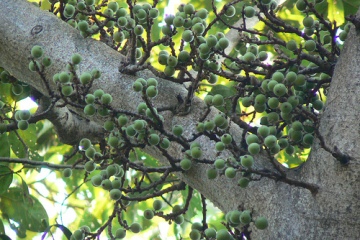
Umbar or Audumbar (Ficus racemosa) - one of the trees best suited for biodiversity. (Image : Dinesh Valke, CC-by-NC-ND)
If you want to attract birds, the Umber or wild fig (Ficus racemosa) is your best bet. If you want a red avenue in summer, it’s the exotic Gulmohar (Delonix regia) you need to choose. For lots of shade with few trees, opt for the Rain tree (Albizia saman).
You can never go wrong by planting Babul (Acacia nilotica) for the welfare of the poorest of the poor – it’s firewood has the highest calorific value.
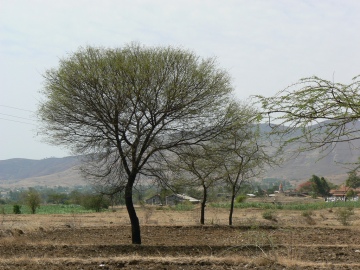
Babul has the highest calorific value of Indian trees and is consequently of great importance to the common man. (Image credit : Dinesh Valke, under CC-BY-NC-ND)
On the other hand, if you don’t do the learning yourself and rely on the “experts”, expect to find that you have created yet another tree-covered barren landscapes by using Kubabul provided by the Forest Department or orchards of stunted Jatropha if you believe
the agro-industrialists.
The real challenge in growing trees is not planting trees but keeping them alive. We can tackle this is many ways.
One is commitment. Choose carefully based on what level of care you can commit. In other words,
“Bite off only what you can chew”
or
“Cut your coat to suit your cloth”.
Our children of the Painted Storks Nature Club wanted to plant trees in the Sarvatra Bird Sanctuary. But it is not possible (or realistic to expect) for the children to come and water the plants since the sanctuary extends over many acres, has lonely corners,
and very little access to water. So we decided to plant in close vicinity of the Middle Lake Garden which is frequented by the children, where water is nearby and where the gardeners can help water these plants.
The Lake Garden provided little scope for useful addition, so we decided to plant some trees and bushes around the CME Lake Mandir where except for a Tulsi plant (Ocimum sanctum var krishna) in front and a Tamarind tree (Tamarindus indica) above the temple,
no other plants were present. It is just 30 meters from the garden and on the lakeshore itself.
We chose our plants carefully. Since we were planting around the mandir (temple), the emphasis was given to shrubs with bright flowers or having perfumed flowers. We tried to choose those which are commonly used for worship in Maharashtra. We also decided to
plant three small-statured trees which would highlight the mandir’s background. We chose well-developed saplings for plantation which were sturdy enough to survive (unintentional) neglect and which already had some flowers so as to enthuse the children and
give them a foretaste of how the garden would look. It was more expensive but worth it.
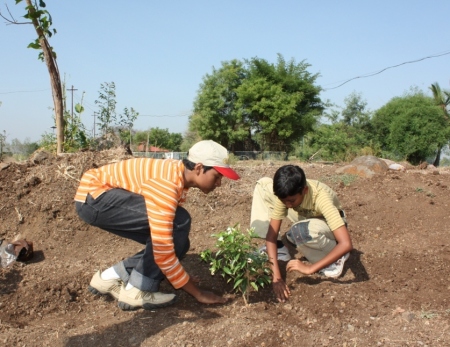
Children plant a shrub with rapt concentration.
The Painted Storks planted the following shrubs on the side of the temple :
* “Juhi” (Jasminum auriculatum)
* “Mogra” or “Madanbaan” (Jasminum sambac)
* “Tagar” or Crepe Jasmine (Tabernaemontana coronaria)
* “Anant” (Gardenia jasminoides)
* Red Hibiscus (Hibiscus rosa-sinensis)
* “Raj Chameli” (Jasminum nitidum)
* “Chameli” (Jasminum flexile)
* “Zai” (Jasminum officinalis)
* “Sarpagandha” (Rauwolfia serpentina), a medicinal plant.
"Juhi" (Jasminum auriculatum)
"Tagar" (Tabernaemontana coronaria)
Behind the temple we planted three saplings of small trees having beautiful flowers :
* “Parijaat” (Nyctanthes arbor-tristis).
* “Savni” or Crepe Myrtle (Lagerstroemia indica).
* “Sonchafa” or “Champak” (Michelia champaca).
"Parijaat" (Nyctanthes arbor-tristis) (Image:JM Garg, CC-BY-SA 3.0)
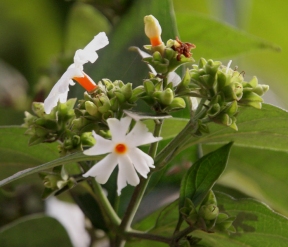
The first tree being planted - a "Parijaat".
That is it – exactly twelve plants, but well chosen, well planted and well-located. What do you think are the odds of survival of these twelve than the desultory planting of many more? And when they do survive which will give the better effect?
One could of course say, don’t confuse gardening with tree-plantation, but the principles are the same.
Problems and dilemmas will arise in this activity, as it does in all of mankind’s ventures. The most important one would that as to how to water the plants regularly. In my opinion, this would be the most difficult of all tasks associated with nurturing trees.
When we know that we cannot come often to water the plants, should we not plant?
We could choose to plant drought resistant native species such as Neem and Babul. We could jury-rig drip irrigation with plastic bottles and tubes which would need less water and give a longer effect. We could mulch the saplings – the mulch helps retain the
water, reduces erosion, suppresses weed growth and seed germination and adds to the fertility over time. We could water in the evening where our water loss due to evaporation will reduce. We could choose to come at a fixed intervals as per our convenience
– say once a fortnight or month, to water the plants accepting the triage due to the environment. We could plant hardy two-three year old saplings rather than very small saplings.
By applying our mind, and by matching our effort to our thought, we can increase the chances of survival of the trees.
If I were to plant a few hectares of arid area in Maharashtra, for example, I would choose native species such as Babul and Ber (Zizyphus jujuba) for the general backdrop, add a few Ficus to form the focal points and plant many interesting but scarce trees.
A few Agaves would help prevent soil erosion in the monsoon run off along with some simple landscaping, a few legumes would help improve the soil condition. There would also be a few creepers, many shrubs (both perennial and annual) and definitely useful grasses
and bamboo. Maybe a few exotic Gliricidia trees to provide ready-made green manure for the caretakers. Amidst these, a few trees or shrubs carefully selected to provide all kinds of resources (nectar, food, shelter, nesting etc) to the typical biodiversity
of that place.
That’s all I can come up with off the cuff. But in reality, the tree plantation scheme for this otherwise hypothetical scheme would be worked out carefully in much greater detail and perhaps even plotted graphically on a map. The location, aim, species available
would all be considered. A planting schedule over two-three years would be considered. The civil engineering works would be restricted to a bare minimum. Nothing more than a fence, water tank or supply. A shed for the forest guard and perhaps minimal amenities
in a place under a shade tree where the nature-lovers can sit, rest, enjoy nature, have their meal etc.
However, I would expect the record-keeping and science to be top class. None of the careless generalities thrown in by so-called experts. The practice of science in even such a routine activity as tree-plantation should be second to none.
That then is my view of tree-planting…
Let’s not just plant trees, let’s craft Nature.
Credits:
My sincere thanks to Mr Nandan Kalbag of www.gardentia.net who dotes on his son-in-law (yours truly) and fielded telephone calls on asking what plants to choose at all times of the day and night.
Members of Indian Tree Pix/EFlora India such as Mr JM Garg & Mr Dinesh Valke (and others) who made images available on the internet with Creative Commons licenses.
|